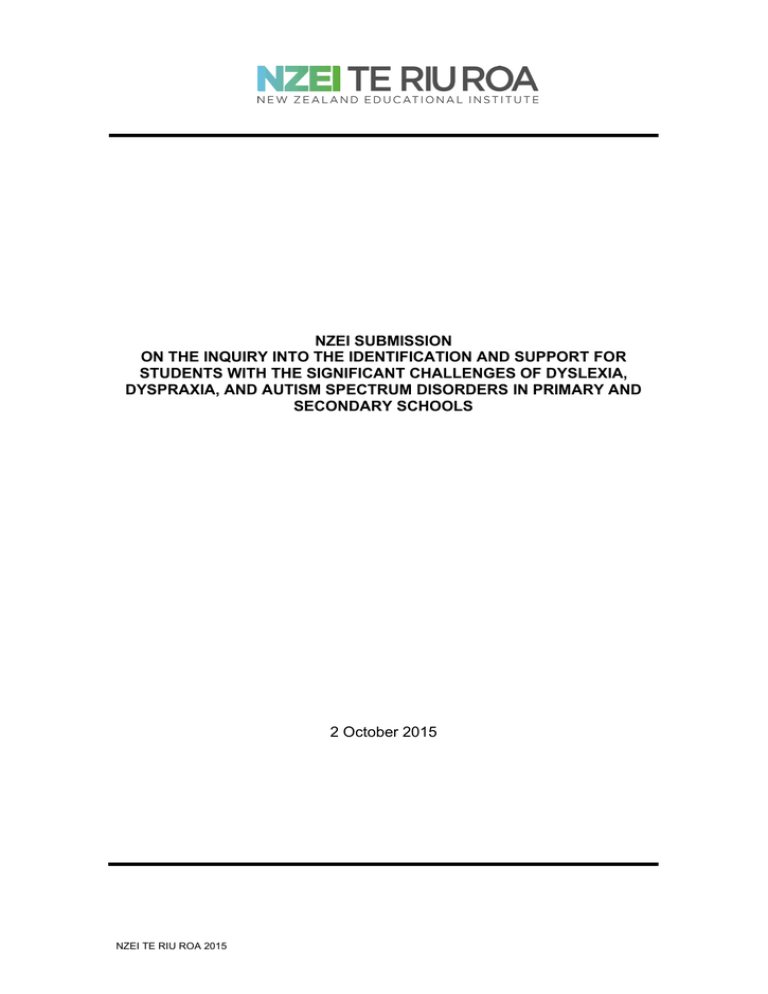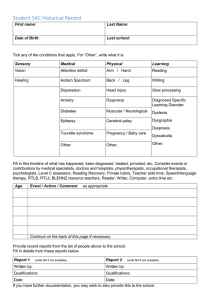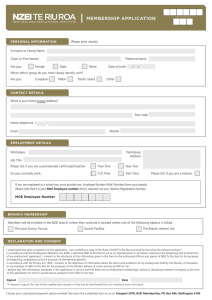submission - New Zealand Parliament
advertisement

NZEI SUBMISSION ON THE INQUIRY INTO THE IDENTIFICATION AND SUPPORT FOR STUDENTS WITH THE SIGNIFICANT CHALLENGES OF DYSLEXIA, DYSPRAXIA, AND AUTISM SPECTRUM DISORDERS IN PRIMARY AND SECONDARY SCHOOLS 2 October 2015 NZEI TE RIU ROA 2015 To: Committee Secretariat, Education and Science NZEI Te Riu Roa Submission INQUIRY INTO THE IDENTIFICATION AND SUPPORT FOR STUDENTS WITH THE SIGNIFICANT CHALLENGES OF DYSLEXIA, DYSPRAXIA, AND AUTISM SPECTRUM DISORDERS IN PRIMARY AND SECONDARY SCHOOLS INTRODUCTION 1 NZEI Te Riu Roa (“NZEI”) is the professional organisation and industrial union that represents the interests and issues of its 50,000 members. Our members are employed as teachers in the early childhood (ECE) and primary sectors (including Kura Kaupapa Māori and Wharekura), support staff in the primary, intermediate, and secondary sectors, school advisers employed by Universities and Colleges of Education, and Special Education staff employed by the Ministry of Education. 2 The main objective of NZEI is to advance the cause of quality public education generally while upholding and maintaining the just claims of its members individually and collectively. 3 NZEI is one of the largest unions and professional bodies in New Zealand and has a long history of playing a positive role in the education sector in particular, and on wider social issues that might affect our members and the children they serve. NZEI Te Riu Roa Response to the inquiry into the identification and support for students with the significant challenges of dyslexia, dyspraxia, and autism spectrum disorders in primary and secondary schools One of our concerns is that while it is important that these significant conditions are investigated, there are many others such as attention deficit (hyperactivity) disorder (AD(H)D), foetal alcohol syndrome (FAS) and various forms of mental illness have not been included. Reid, Elbeheri and Everatt (2016) note specific learning difficulties can be seen in a continuum and there are often overlaps with conditions, particularly those of dyslexia and dyspraxia. Therefore, it is important to define what is meant by dyslexia, dyspraxia and autism spectrum disorders. Academics suggest that “dyslexia is a processing difference … often characterized [sic] by difficulties in literacy, it can affect other cognitive areas such as memory, speed of processing, time management, coordination and directional aspects” (Reid et al., 2016). Other researchers would argue that this definition encompasses all struggling readers and that “the fundamental problem is that dyslexia lacks any agreed scientific definition” (Elliott & Gibbs, 2012, p. 265). Consequently, there are no agreed scientific approaches for dealing with those labelled ‘dyslexic’ (Elliott & Gibbs, 2012). Resourcing may be available for students who are diagnosed 2 dyslexic. However, support is required for all learners who have difficulty gaining literacy skills. Dsypraxia is an “impairment or immaturity in the organisation of movement which leads to associated problems with language, perception and thought” (Dyspraxia Trust, 2001, as cited in Reid et al., 2016) Autism Spectrum Disorder (ASD) “refers to a group of developmental disabilities that can cause significant communication, social and behavioural challenges” (BevanBrown, 2015, p. 175). Overall, it is important that all learners who are having difficulty with learning receive the support that they need. 1. Identify best educational practice for dyslexic, dyspraxic, and autism spectrum students. Programmes that are shown to be most effective for learners with ASD “incorporate 1-to-1, direct instruction using behavioural techniques, begin rapidly upon diagnosis, and teach a comprehensive curriculum including academic, daily living, language, play, and social skills. Children involved in such programmes have been reported to make substantial, lasting progress with the best gains recorded by children who start intervention programmes at 2 or 3 year of age. The likely outcome for most children with ASD who do not receive early, intensive, behavioural intervention is a need for lifelong specialised services” (Auckland UniServices, 2003, p. xvii). The need for early intervention is highlighted by other research. One of the key recommendations for ‘education for learners with ASD’ is “interventions should start early, as soon as significant developmental delay is recognised, and be proactive…” (Ministries of Health and Education, 2008, p. 15). If this is the case, why has early childhood education been excluded from this inquiry? One of the most important considerations is that any ASD programme is “delivered by individuals with extensive training in the methods of applied behaviour analysis” (Auckland UniServices, 2003, p. xvii). It is suggested that some programmes provided in the mainstream are simply a waste of resources, because they are ineffective methods, delivered by the untrained (Auckland UniServices, 2003). 2. Investigate current screening for dyslexia, dyspraxia, and autism spectrum disorders in primary and secondary schools. At present, a diagnosis of dyslexia, dyspraxia or ASD must be made through a professional, commonly a psychologist (Autism New Zealand, n.d; Dyslexia Foundation of New Zealand, n.d; The Dyspraxia Support Group of NZ, n.d). While people may be able to access services through their local doctor, the waiting lists may be long, (Bevan-Brown, 2015) and the cost of going privately too great (The Dyspraxia Support Group of NZ, n.d). While there are effective services available for learners with ASD, accessing them can be difficult. This may be because parents/caregivers are unaware of the service 3 and they also need to meet the associated costs (Auckland UniServices, 2003). The government provides some support but this is often not enough and access to services becomes an equity issue (Auckland UniServices, 2003). 3. Investigate support available to and in schools for the transition through education for students with dyslexic, dyspraxic, and autism spectrum disorders, and the adaptions for the learning including Special Assessment Conditions. State funding for learners with ASD in the mainstream, which includes teacher aides and education support workers appears to be inconsistent (Auckland UniServices, 2003). The level of funding that a child gets appears to be more related to the ability of the parent to secure funding, rather than the level of functioning that a child has (Auckland UniServices, 2003). Many learners with dyslexia, dyspraxia and ASD would benefit from having support staff that stay with them during their schooling experiences. This is particularly important at key transition points, such as from early childhood to primary school, and from primary school to secondary school. However, teacher aides and education support workers are not generally permanent staff members (Ministry of Education, New Zealand School Trustees Association, & NZEI Te Riu Roa, 2011). Another factor around the effectiveness of transitions is that they are often dependent on the skills/capabilities and capacity of particular services and schools. Historically, special assessment conditions (SAC) have been difficult to access, with students from higher decile schools more likely to qualify (Ministry of Education, 2014) This situation has not really improved for students with dyslexia, dyspraxia or ASD, who appear to require extensive reports before they qualify for assistance (New Zealand Qualifications Authority, n.d). If such reports are essential, they could be provided free of charge to enhance equitability of access to SAC. 4. Investigate whether teacher training and professional development prepare teachers to identify and support the education of dyslexic, dyspraxic, and autism spectrum students. Concerns have been raised by parents, at the recent Special Education Update meetings, about the lack of specialist knowledge that teachers have about specific conditions. Parents believe that learning about a range of conditions should be a part of ITE and ongoing PLD. Initial teacher education (ITE) is provided by a range of polytechnics and universities in New Zealand. All have different programmes and courses around inclusive education and the emphasis that particular conditions will have (Morton & Gordon, 2006). Some academics are less than complimentary about the preparation that training teachers receive. “It is a myth that pre-service and in-service teacher education programmes in New Zealand adequately prepare teachers for meeting different literacy learning needs of children on school entry” (Chapman, Prochnow, & Arrow, 4 2015, p. 230). Other researchers recognise that “knowledge of ASD among professionals … is limited” (Bevan-Brown, 2015, p. 195). There is a lack of a nationwide strategy to address this situation and a lack of PLD available to teachers on these particular conditions. It is also a concern that the outcome of the PLD review announced this week has done nothing to prioritise these issues. 5. Review the implementation of the 2008 NZ Autism Spectrum Disorder Guideline recommendations specific to education, to assess the level of progress. There is still a great day of work to do, to implement the recommendations in the New Zealand Autism Spectrum Disorder Guidelines. Under ‘key recommendations for education for learners with ASD’ it is noted that “interventions should start early, as soon as significant developmental delay is recognised, and be proactive. The child or young person’s programme should be indivdiualised and designed to engage the child or young person and provide a highly supportive environment” (Ministries of Health and Education, 2008, p. 15). To ensure that this takes place, all schools and early childhood services need to be inclusive. A recent Education Review Office report found that 77% of schools sampled had mostly inclusive practices (Education Review Office, 2015). While this is an increase from 2010 (Education Review Office, 2015), clearly there is still further work required to guarantee that all students with ASD receive the support that they require. Another recommendation that does not always receive the consideration that it should is “all transitions for students with ASD should be carefully planned and the child or young person and the new environment carefully prepared” (Ministries of Health and Education, 2008, p. 15). There are several reasons why this may not occur, particularly in the transition between early childhood services and school. This is because at this particular transition, funding for the learner has to be sought from alternative funding pools. Under ‘key recommendations for professional learning and development’ it is noted that “all professionals who come into contact with children, whether in health care services, early childhood education centres or primary schools should receive training on ‘alerting signals’ of possible ASD” (Ministries of Health and Education, 2008, p. 20). For current, practicing teachers, there is no, and has not been, a nationwide programme to address the training need of ‘alerting signals’ of possible ASD. For those training to be teachers, courses on inclusion and special needs education are more likely to be taught in primary initial teacher education programmes than in secondary (Morton & Gordon, 2006). This is because secondary teacher programmes are more likely to be only single year courses (Morton & Gordon, 2006). After examination of a range of course outlines from all ITE providers, indicators are that single year training courses for both early childhood and primary school teachers are becoming more prevalent (NZEI Te Riu Roa, 2015). 5 Another recommendation is “professional learning and development should be consistent with evidence and principles of quality provision” (Ministries of Health and Education, 2008, p. 20). Since the introduction of Tomorrow’s Schools all schools are self-managing, which means that generally, each school is responsible for organising, sourcing and paying for professional development for staff members. A consequence of this is variability in the quality and quantity of courses that are run on ASD, and access to courses is also an issue, particularly for those who are working in rural or remote areas. This relates to a further recommendation, “distance learning opportunities should be developed for those working away from main centres” (Ministries of Health and Education, 2008, p. 21). Some courses, such as Tips for Autism, while highly regarded, are also expensive. This is not because of the actual course costs, as courses are provided free of charge. The expense is due to the costs involved in teacher release, and the costs of accommodation/travel for those who do not live close to where courses are being run. There is also a reliance on those staff members who attended the course passing on the information gained to the child’s future teachers. While Tips for Autism includes general principles that can be applied to other students with ASD, the course is set up to support individual students and their whanau, as the course is attended by the parents/caregivers and those teachers/teacher aides working directly with the learner ("Tips for autism," n.d). A further recommendation is “in addition to workshops and seminars, all professionals and paraprofessionals who are learning new skills should be offered opportunities for practice, coaching and feedback” (Ministries of Health and Education, 2008, p. 21). As previously noted, this may be happening in some schools and early childhood services, but there is currently no nationwide strategy to ensure that this is an option for all. It could be said in a school setting, it is the responsibility of a school special education needs coordinator (SENCO) to provide education and support to others. The New Zealand Autism Spectrum Disorder Guideline Summary recommends that “priority for professional learning and development should be given to those who provide a specialist or consultancy service and support and education to others” (Ministries of Health and Education, 2008, p. 21). To date, there has been no nationwide professional development and learning for SENCOs in ASD. 6 Recommendations 1. More equitable access to resources for recognition, diagnosis and early intervention 2. On-going resourced intervention by trained experts 3. Secure, on-going employment and career pathways for teacher aides and Education Support Workers, thus ensuring stability and continuity for students 4. Significant investment in PLD for teachers and teacher aides working with children with special education needs 5. Improved initial teacher education that addresses working with learners with conditions such as dyslexia, dyspraxia, ASD. Paul Goulter National Secretary Korimako Tangiata October 2015 7 References Auckland UniServices. (2003). An evaluation of some programmes for children with autistic spectrum disorder in Auckland: Opportunities, contingencies, and illusions. Wellington, New Zealand: Ministry of Education. Autism New Zealand. (n.d). Diagnosis. Retrieved from http://www.autismnz.org.nz/local_branches/northland/diagnosis Bevan-Brown, J. (2015). Maori and autism specturm disorder. In J. Bevan-Brown, M. Berryman, H. Hickey, S. Macfarlane, K. Smiler, & T. Walker (Eds.), Working with Maori children with special education needs: He mahi whakahirahira (pp. 174-196). Wellington, New Zealand: NZCER. Chapman, J. W., Prochnow, J. E., & Arrow, A. W. (2015). Eleven myths about literacy education in New Zealand. In W. E. Tunmer & J. W. Chapman (Eds.), Excellence and equity in literacy education: The case of New Zealand (pp. 214-235). Hampshire, England: Palgrave Macmillan. Dyslexia Foundation of New Zealand. (n.d). Members: Dyslexia assessment providers. Retrieved from http://www.dyslexiafoundation.org.nz/dyslexia_assproviders.html Education Review Office. (2015). Inclusive practices for students with special education needs in schools. Retrieved from http://ero.govt.nz/National-Reports/Inclusive-practices-for-students-with-specialeducation-needs-in-schools-March-2015/Findings Elliott, J. G., & Gibbs, S. (2012). The dyslexia debate. In P. Adey & J. Dillon (Eds.), Bad education: Debunking myths in education (pp. 263-277). New York, NY: Open University Press. Ministries of Health and Education. (2008). New Zeland autism spectrum disorder guideline summary. Wellington, New Zealand: Ministry of Health. Ministry of Education. (2014). Review of special assessment conditions for National Certificate of Educational Achievement (NCEA): A report for the Ministry of Education and the New Zealand Qualifications Authority (NZQA) Retrieved from http://www.education.govt.nz/assets/Documents/School/Supporting-students/Students-with-SpecialNeeds/SpecialAssessmentConditions7March2014PDF.pdf Ministry of Education, New Zealand School Trustees Association, & NZEI Te Riu Roa. (2011). School support staff: Collectively making resources count. Wellington, New Zealand: Ministry of Education. Morton, M., & Gordon, L. (2006). In the public good? Preparing teachers to be inclusive educators: Report of a New Zealand research project. Paper presented at the American Educational Research Association Conference, San Francisco. New Zealand Qualifications Authority. (n.d). Special assessment conditions - documentation requirements. Retrieved from http://www.nzqa.govt.nz/providers-partners/assessment-and-moderation/managingnational-assessment-in-schools/special-assessment-conditions/documentation-requirements/ NZEI Te Riu Roa. (2015). Table of ITE providers. Wellington, New Zealand: Author. Reid, G., Elbeheri, G., & Everatt, J. (2016). Assessing children with specific learning difficulties. Oxon, United Kingdom: Routledge. The Dyspraxia Support Group of NZ. (n.d). So you think your child may have developmental dyspraxia? . Retrieved from http://www.dyspraxia.org.nz/index.php?page=where-do-i-go-for-help Tips for autism. (n.d). Retrieved from http://www.tipsforautism.org.nz/ 8



